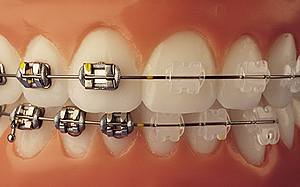Everything about Ceramic Braces . For generations, metal braces have been the typical treatment for correcting orthodontic issues. But in recent years, the dental community has seen a revolution in tooth straightening with the development of ceramic braces. Many people are now turning to ceramic braces as an attractive option for improving their smile.
What are Ceramic Braces?
Ceramic braces use the same technology as metal braces but are made from a clear or tooth-colored material. They fit snugly and unobtrusively over the teeth, meaning they blend in with your smile and are hardly noticeable to other people. Most ceramic braces are actually made from a form of polycrystalline alumina, a material that’s both biocompatible and incredibly strong.

Benefits of Ceramic Braces
The primary benefit of ceramic braces is aesthetics. Unlike metal braces, ceramic braces are practically invisible when you smile and this can help to ease the anxiety of wearing braces for many individuals. On top of this, ceramic braces are also more comfortable than traditional braces because the elastic ties used to secure them are less likely to irritate the gums and lips.
Who are Ideal Candidates for Ceramic Braces?
Ceramic braces are ideal candidates for anyone looking for an aesthetically pleasing alternative to traditional metal braces. Additionally, the clear braces are preferred by many adults hoping to discreetly address problems with misalignment or crowded teeth. This is because, unlike traditional braces, ceramic braces offer a far less obvious solution that’s barely visible while still delivering effective results.
How Long Does Treatment Last?
Like traditional braces, ceramic braces typically take between 1-3 years for most patients to effectively adjust their teeth. However, the exact duration of treatment depends on the type and severity of the issue being treated. In some cases, ceramic braces may be removed sooner than metal braces due to the smoother finish.
Are There Risks or Side Effects?
While ceramic braces offer many advantages, they do come with some side effects. The brackets used to secure the braces can sometimes cause irritation to the mouth and lips. There is also a risk that the ceramic brackets could break if exposed to excessive force or pressure. Considering these potential risks, it is important to consult with an orthodontist to develop a proper treatment plan.
Caring for Braces during Treatment
When caring for ceramic braces, it is essential to practice good oral hygiene. Eating certain types of food should be avoided as they can damage the brackets and wire and cause increased discomfort. Examples of foods that are best avoided include popcorn, nuts, candy, hard fruits, and hard bread. It is also important to clean the braces and brush around the wires regularly to reduce the chances of bacteria build-up. Lastly, regular visits to the orthodontist should be scheduled to ensure the teeth are progressing correctly.
Overall, ceramic braces provide a great alternative to traditional metal braces for anyone wanting to improve their smile in a discreet manner. With proper care and maintenance, ceramic braces can work fast and deliver lasting results. But it is important to remember that each case is unique and you should consult with an orthodontist to determine if ceramic braces are right for you.
